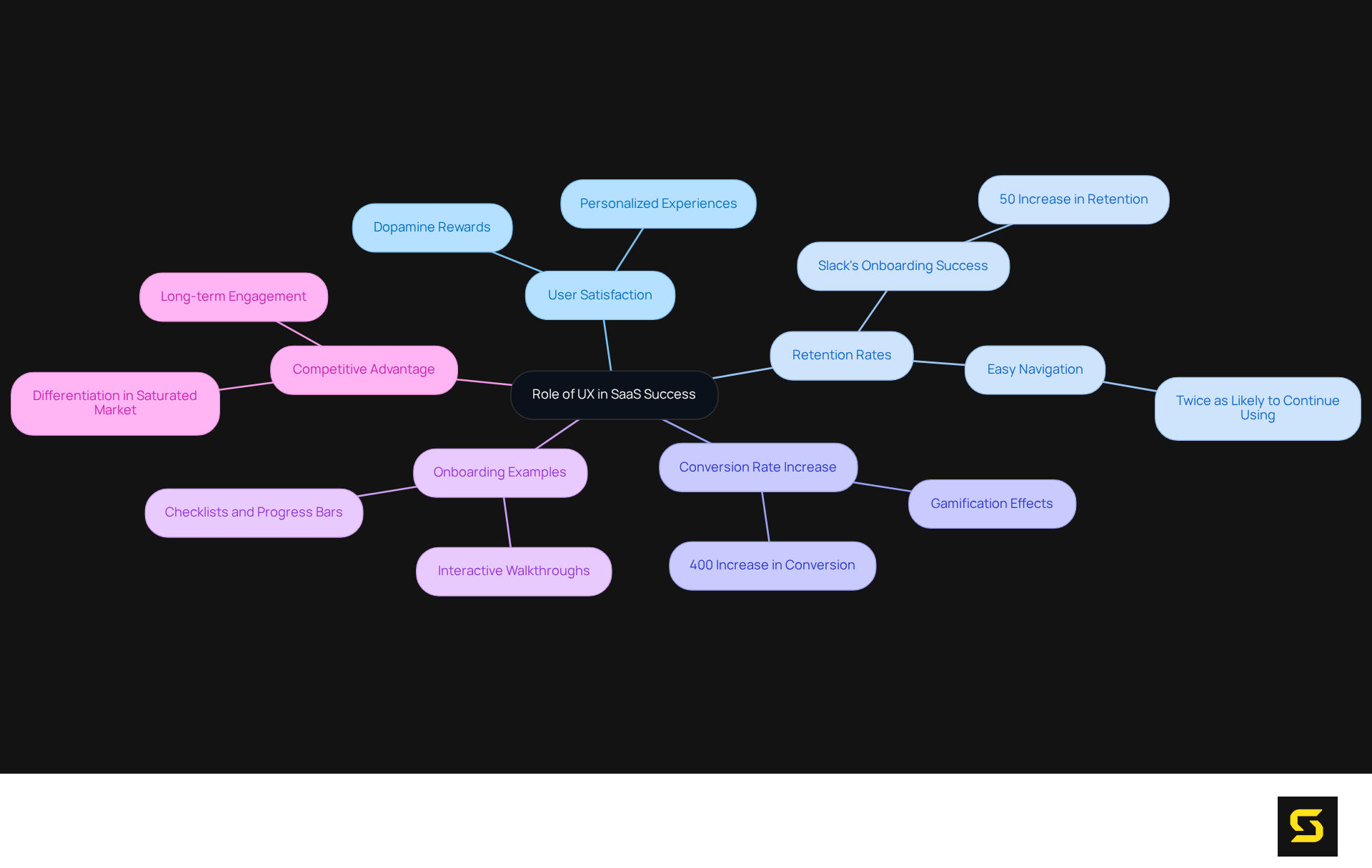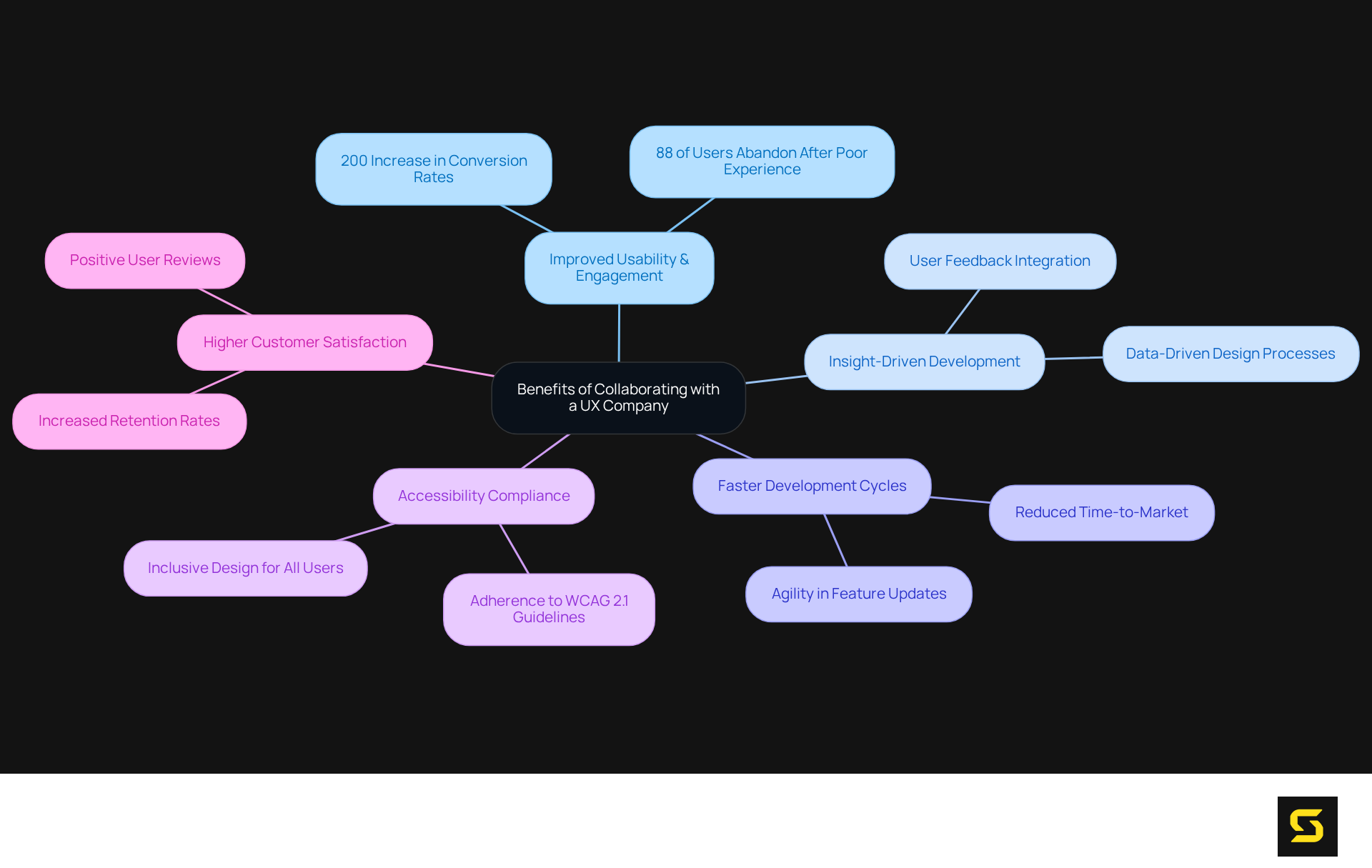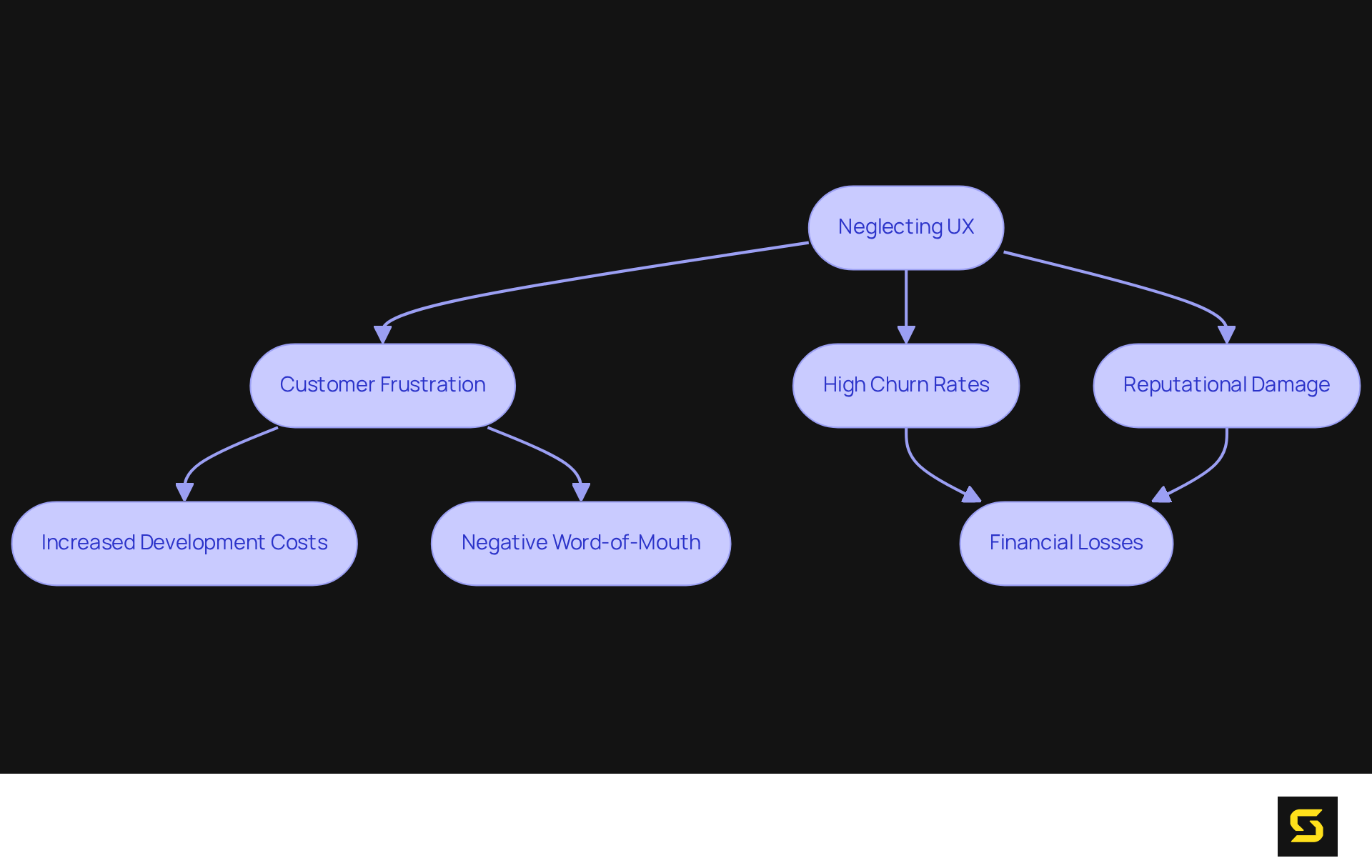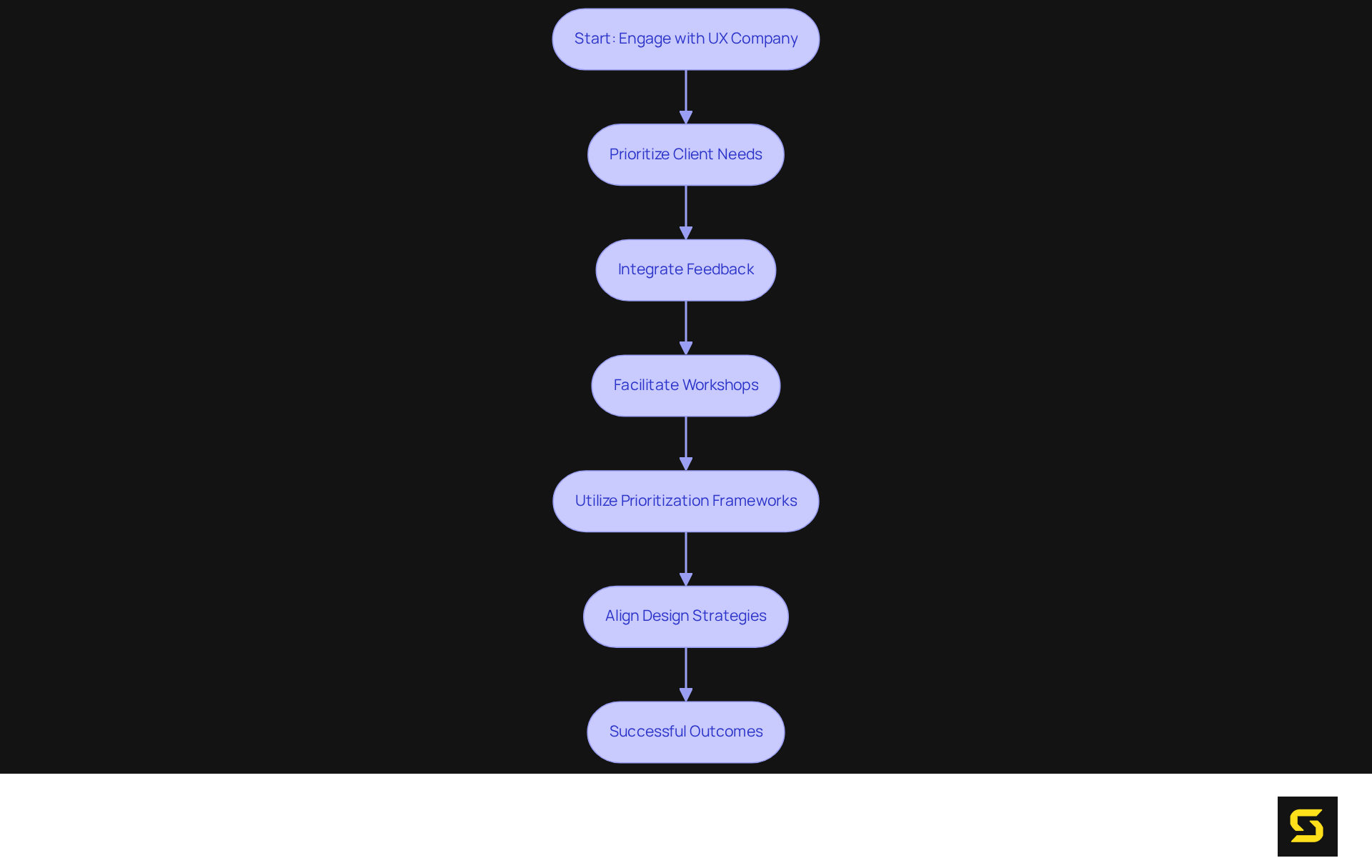Overview
Partnering with a UX company is essential for driving SaaS success, as it significantly enhances user satisfaction and retention through specialized design strategies that prioritize client experience. Effective UX not only elevates user engagement but also leads to substantial increases in conversion rates and reduced churn. This demonstrates that a strong focus on user experience directly influences a SaaS product's market performance and fosters customer loyalty. To capitalize on these insights, businesses must recognize the critical role of UX in their growth strategy.
Introduction
Crafting a successful SaaS product in today's competitive landscape requires more than just innovative features; it hinges on delivering an exceptional user experience (UX). As the digital marketplace becomes increasingly crowded, companies that prioritize UX not only enhance customer satisfaction but also significantly boost their conversion rates. The pressing question is: how can SaaS providers effectively harness the power of UX to stand out and maintain user loyalty? This article delves into the pivotal role of partnering with a UX company, exploring the tangible benefits of prioritizing user experience in software development and the potential pitfalls of neglecting it.
Understand the Role of UX in SaaS Success
User Experience (UX) is a cornerstone of success for software solutions, significantly influencing interactions with applications. A thoughtfully crafted UX enables users to navigate applications effortlessly, resulting in increased satisfaction and retention rates. In a saturated SaaS market, where choices abound, an exceptional UX can distinctly set a product apart from its competitors.
Research indicates that companies prioritizing UX can realize up to a 400% increase in conversion rates, underscoring the monetary advantages of investing in aesthetics (Codewave). Moreover, effective UX strategies minimize the learning curve for newcomers, fostering quicker adoption and reducing churn. By embracing customer-focused principles, software-as-a-service firms can create solutions that not only fulfill functional requirements but also resonate emotionally with individuals, nurturing loyalty and promoting long-term engagement.
For instance, Slack's intuitive onboarding process has been shown to enhance customer retention by up to 50%, illustrating the tangible impact of strategic UX improvements. Furthermore, users are twice as likely to continue utilizing an app that is easy to navigate, emphasizing the critical role of intuitive design in retention.
As the sector evolves, emphasizing UX will be vital for any UX company aiming to thrive in a competitive landscape, as even a single misstep can lead to client loss (Keith Shields).

Explore the Benefits of Collaborating with a UX Company
Partnering with a UX company offers significant advantages for SaaS providers. These firms bring specialized knowledge in client-focused creation, which is essential for developing interfaces that enhance usability and engagement. Studies indicate that a well-crafted interface can lead to over a 200% increase in conversion rates, as highlighted in the case study "Conversion Rate Boost through Intuitive Layout," demonstrating the direct correlation between UX/UI and sales performance.
Moreover, a UX company conducts thorough research to gather insights that inform development decisions, ensuring products align with consumer expectations. This strategy is critical, given that 88% of users abandon a platform after a poor experience, underscoring the necessity for effective UX strategies.
In addition, collaborating with a UX company can significantly expedite development cycles. These specialists streamline the development process, allowing for quicker iterations and reducing the need for extensive revisions later on. This agility is crucial in the fast-paced SaaS landscape, where rapid time-to-market is essential for attracting early adopters and maintaining a competitive advantage.
Accessibility compliance is another fundamental aspect of UX design, as outlined in the case study "Accessibility Compliance in Enterprise Applications." Ensuring applications are accessible to all, including individuals with disabilities, enhances overall satisfaction and broadens the reach of the offering.
Ultimately, this partnership with a UX company results in a refined outcome that not only meets market demands but also enhances customer satisfaction. Organizations leveraging the expertise of UX agencies often experience higher retention rates and improved ROI, positioning such collaborations as a strategic investment in the success of their software offerings.

Identify Risks of Ignoring UX in SaaS Development
Neglecting client experience (UX) in SaaS development presents significant risks that can jeopardize a service's success. One of the most immediate consequences is customer frustration, which often leads to high churn rates. Research indicates that 70% of churn can be attributed to usability problems, as users are quick to abandon products that are difficult to navigate or understand. This frustration is further exacerbated by the fact that 32% of consumers would abandon a brand they love after just one negative experience, highlighting the fragility of customer loyalty in the face of poor UX. As Amish Karanwal notes, "Frustrated individuals are likely to share their negative experiences with colleagues and peers," underscoring the importance of ensuring a positive experience.
Moreover, the reputational damage caused by negative customer experiences can be profound. Frustrated individuals tend to express their dissatisfaction through word-of-mouth and online reviews, which can severely impede customer acquisition efforts and diminish market share. For instance, Snapchat's 2018 redesign backlash resulted in a staggering $1.3 billion drop in market value, demonstrating how swiftly a brand's reputation can be tarnished by UX missteps. This aligns with the broader theme of how poor UX can lead to significant financial repercussions, as evidenced by Apple's initial release of Apple Maps, which cost the company approximately $30 billion due to a poor user experience.
Additionally, neglecting UX can lead to increased development costs over time. Teams may find themselves allocating additional resources to rectify usability issues that could have been addressed during the initial design phase. This reactive approach not only strains budgets but also delays enhancements, ultimately compromising the overall success of the service offering.
In conclusion, prioritizing the approach of a UX company from the outset is essential for software companies to mitigate these risks, enhance client retention, and maintain a competitive edge in a crowded market.

Enhance Product Development Through UX Collaboration
Enhancing item development through collaboration with a UX company is essential for embedding client feedback and design principles throughout the software development lifecycle. By engaging closely with a UX company, SaaS teams can prioritize client needs, leading to more effective, client-centric solutions. This collaboration cultivates a culture of continuous improvement at the UX company, where insights from various stakeholders are systematically integrated into development processes. For instance, companies like Airbnb have successfully involved engineers from the outset, ensuring that client experience remains a priority without sacrificing scalability.
Research indicates that organizations with integrated teams from a UX company and engineering experience fewer product failures and higher adoption rates, underscoring the critical role of feedback in SaaS development. Moreover, utilizing prioritization frameworks, such as the Eisenhower Box, can help teams categorize tasks effectively, ensuring that vital client needs are addressed promptly.
UX specialists can also facilitate workshops and brainstorming sessions that unite cross-functional teams around client objectives and design strategies. This collaborative approach not only yields a more user-friendly end product but also aligns it more closely with the demands of a UX company. Ultimately, this synergy enhances user satisfaction and significantly contributes to business success. As highlighted, "Companies that prioritize cross-functional teams where designers, engineers, and product managers collaborate from the ideation phase consistently outperform those with rigid, isolated workflows.

Conclusion
Investing in user experience (UX) is not just important; it is essential for the success of software-as-a-service (SaaS) offerings. A well-designed UX significantly enhances user satisfaction and boosts retention and conversion rates. In a competitive market, where myriad options abound, a superior user experience can be the defining factor that determines a product's success or failure.
This article underscores several key points, particularly the substantial advantages of collaborating with a UX company. Such partnerships grant access to specialized expertise that can lead to increased conversion rates, improved user engagement, and expedited development cycles. Conversely, neglecting UX can result in high churn rates, reputational damage, and escalating costs due to necessary revisions. Real-world examples, such as Slack's onboarding success and the challenges faced by Snapchat, highlight the tangible impact of prioritizing UX in SaaS development.
Ultimately, the significance of user experience in SaaS cannot be overstated. Companies must recognize that investing in UX is not merely an option but a strategic necessity that propels long-term success. By prioritizing collaboration with UX experts, SaaS providers can create products that resonate with users, foster loyalty, and maintain a competitive edge in an ever-evolving landscape. Embracing these principles will not only enhance customer satisfaction but also pave the way for sustainable growth and profitability.
Frequently Asked Questions
What is the importance of User Experience (UX) in SaaS success?
UX is crucial for SaaS success as it significantly influences user interactions with applications, leading to increased satisfaction and retention rates. A well-designed UX allows users to navigate applications easily, which is essential in a competitive market.
How does prioritizing UX impact conversion rates?
Companies that prioritize UX can see up to a 400% increase in conversion rates, highlighting the financial benefits of investing in user-friendly design.
What are the benefits of effective UX strategies for new users?
Effective UX strategies reduce the learning curve for newcomers, facilitating quicker adoption and minimizing churn rates.
How does a customer-focused approach affect SaaS solutions?
A customer-focused approach helps SaaS firms create solutions that meet functional needs and resonate emotionally with users, fostering loyalty and long-term engagement.
Can you provide an example of a company that successfully implemented UX improvements?
Slack is an example where an intuitive onboarding process has improved customer retention by up to 50%, demonstrating the positive impact of strategic UX enhancements.
What is the relationship between app navigation and user retention?
Users are twice as likely to continue using an app that is easy to navigate, emphasizing the critical role of intuitive design in retaining users.
Why is it important for UX companies to focus on UX as the sector evolves?
As the SaaS sector evolves, emphasizing UX is vital for companies to thrive in a competitive landscape, as even minor missteps can lead to the loss of clients.





